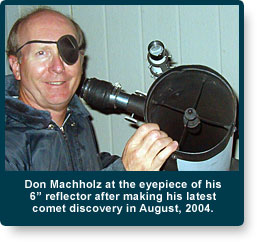In the Beginning...
It was 33 years ago that I decided to pursue a systematic search for comets. This decision came at a pivotal time in my life. I had just finished serving three years in the military, had moved back home, and I wanted a project that would encourage me to spend more time viewing the heavens. Over the previous decade I spent considerable time viewing all the planets and a half-dozen comets, found every Messier Object in one year (1969-70), and photographed the skies. I have always enjoyed the view of the night sky through the telescope. The projects that I considered were: variable stars, asteroid studies, and comet hunting.
 Comet hunting seemed most appealing to me. I also knew that very few Americans were searching for comets, because most visual discoveries were being made from foreign lands. According to James Muirden (The Amateur Astronomer's Handbook), the average comet hunter took 300 hours to find a new comet. This was confirmed to me when I read an interview with William Bradfield appearing in the magazine Eclipse. There he said his first discovery took 260 hours and his second took an additional 306 hours. My early philosophy developed: I would attempt systematic comet hunting for as long as I found it enjoyable. If I did not find it enjoyable, I could quit my comet hunting program and move on to something else, my only "loss" being the time spent looking through the telescope. And if I enjoyed it, I'd continue my comet hunting program. Finally, I wanted my comet hunting program, as extensive as it might become, to be only a part of my life, not to consume it. I did not want to exclude other activities or people from my life just because I wanted to hunt comets.
Comet hunting seemed most appealing to me. I also knew that very few Americans were searching for comets, because most visual discoveries were being made from foreign lands. According to James Muirden (The Amateur Astronomer's Handbook), the average comet hunter took 300 hours to find a new comet. This was confirmed to me when I read an interview with William Bradfield appearing in the magazine Eclipse. There he said his first discovery took 260 hours and his second took an additional 306 hours. My early philosophy developed: I would attempt systematic comet hunting for as long as I found it enjoyable. If I did not find it enjoyable, I could quit my comet hunting program and move on to something else, my only "loss" being the time spent looking through the telescope. And if I enjoyed it, I'd continue my comet hunting program. Finally, I wanted my comet hunting program, as extensive as it might become, to be only a part of my life, not to consume it. I did not want to exclude other activities or people from my life just because I wanted to hunt comets.
The remainder of December 1974 was spent setting up my comet hunting program and practicing under the night sky. I divided my sweepable sky into 40 sections, excluding dense Milky Way and galaxy-laden areas. (This lasted less than a year, then I opened up the whole sky for sweeping). The instrument I used was a 11 cm., f/5 reflector at 20x, with a field of view of about 3 degrees. The mount was from my 15 cm Criterion Dynascope. Within a year I transferred it to an equatorial (unguided) pipe mount.
